Harman-Kardon AVR 7000 User Manual
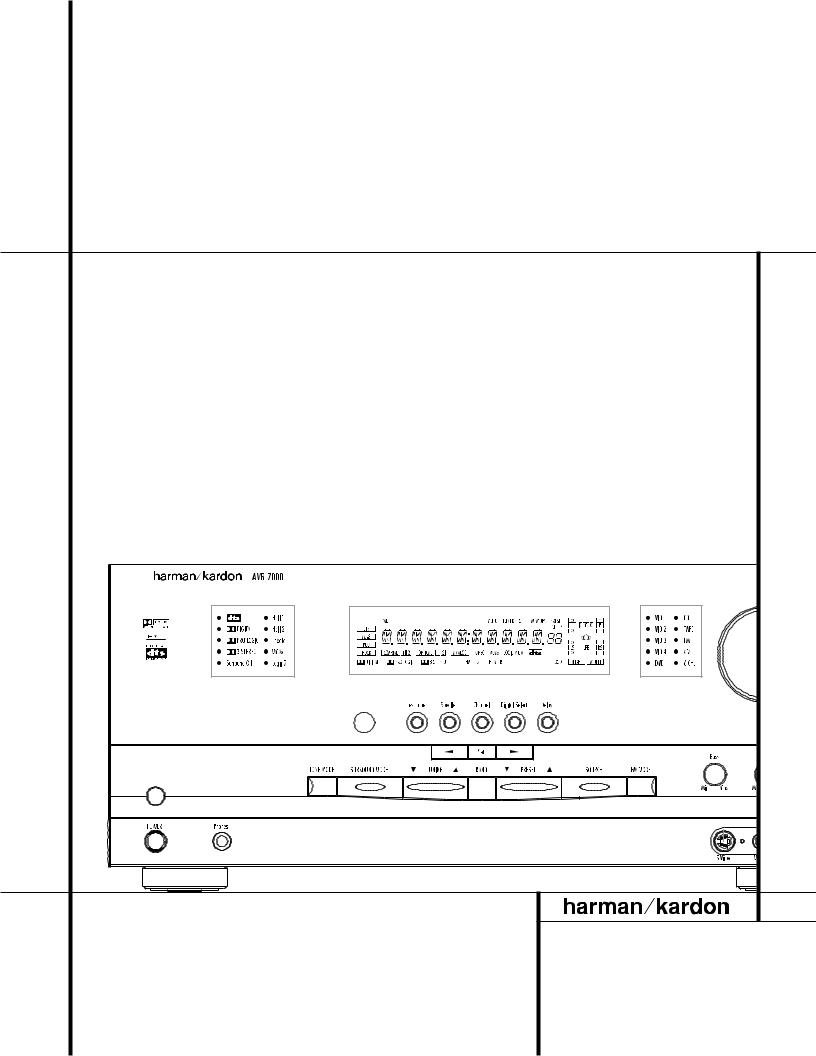
AVR 7000 Audio/Video Receiver |
OWNER’S MANUAL |
® |
Power for the digital revolution.™

AVR 7000 Audio/Video Receiver
3Introduction
4Safety Information
4Unpacking
5Front Panel Controls
7 Front Panel Information Display
9 Rear Panel Connections
11 Main Remote Control Functions
14Zone II Remote Control Functions
15Installation and Connections
18 System Configuration
20Input Setup
20Surround Setup
20Delay Settings
21Crossover Frequency
22Speaker Setup
23Output Level Adjustment
25Operation
25Basic Operation
25Source Selection
25Surround Mode Selection
26Surround Mode Chart
27Digital Audio Playback
29Tuner Operation
29Tape Recording
29Output Level Trim Adjustment
306-Channel Direct Input
31Advanced Features
31Front Panel Input/Output Connections
31Display Brightness
31Turn On Volume Level
32OSD Settings
33Multiroom Operation
34Programming the Remote
34Direct Code Entry
34Auto Search Method
34Code Readout
35Learning Codes From a Remote
35Macro Programming
36Programmed Device Functions
36Volume Punch-Through
37Reassigning Device Control Selectors
37Erasing Learned Codes
38Function List
39Setup Code Tables
46Troubleshooting Guide
46Processor Reset
47Technical Specifications
Typographical Conventions
In order to help you use this manual with the remote control, front-panel controls and rear-panel connections, certain conventions have been used.
EXAMPLE – (bold type) indicates a specific remote control or front-panel button, or rear-panel connection jack
EXAMPLE – (OCR type) indicates a message that is visible on the front-panel information display
EXAMPLE – (outlined type) indicates a lit indicator in the front-panel information display
1– (number in a square) indicates a specific front-panel control
¡ – (number in a circle) indicates a rear-panel connection
a– (number in an oval) indicates a button or indicator on the remote
A– (letter in a square) indicates an indicator in the front-panel display
å– (letter in an oval) indicates a button on the Zone II remote
2 TABLE OF CONTENTS
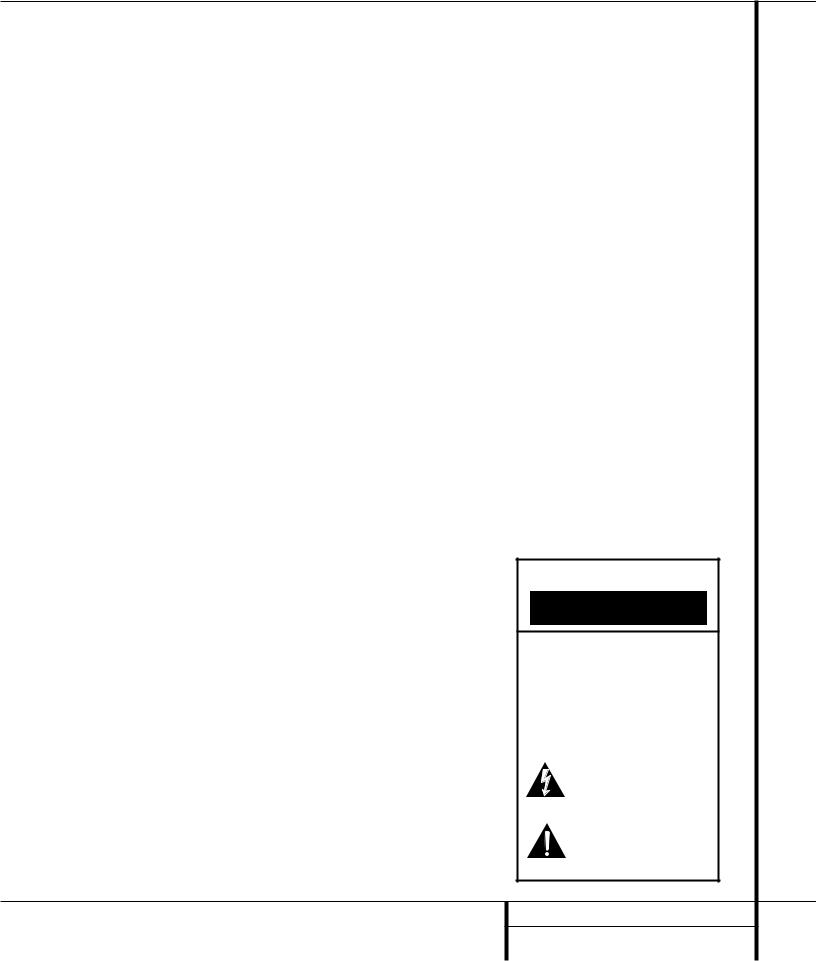
Introduction
Thank you for choosing Harman Kardon!
With the purchase of a Harman Kardon
AVR 7000 you are about to begin many years of listening enjoyment. The AVR 7000 has been custom designed to provide all the excitement and detail of movie sound tracks and every nuance of musical selections. With onboard Dolby* Digital and DTS† decoding, the
AVR 7000 delivers six discrete channels of audio that take advantage of the digital sound tracks from the latest DVD and LD releases and Digital Television broadcasts.
While complex digital systems are hard
at work within the AVR 7000 to make all of this happen, hookup and operation are simple. Color-keyed connections, a backlit, programmable remote control, and on-screen menus make the AVR 7000 easy to use. To obtain the maximum enjoyment from your new receiver, we urge you to take a few minutes to read through this manual. This will ensure that connections to speakers, source playback units and other external devices are made properly. In addition, a few minutes spent learning the functions of the various controls will enable you to take advantage of all the power the AVR 7000 is able to deliver.
If you have any questions about this product, its installation or its operation, please contact your retailer or custom installer. They are your best local source of information.
Description and Features
The AVR 7000 is among the most versatile and multi-featured A/V receivers available, incorporating a wide range of listening options. In addition to Dolby Digital and DTS decoding for digital sources, a broad choice of analog surround modes are available for use with sources such as CD, VCR, TV broadcasts and the AVR’s own FM/AM tuner. Along with Dolby Pro Logic*, Dolby 3 Stereo and custom Hall and Theater
modes, only Harman Kardon receivers offer Logic 7® to create a wider, more enveloping field environment and more defined fly-overs and pans. The AVR 7000 is also the only receiver that offers HDCD® decoding to provide the most realistic playback of CDs when a digital connection is used. Another Harman Kardon exclusive is VMAx™, which uses proprietary processing to create an open, spacious sound field even when only two front speakers are available.
No matter how sophisticated your system components, the AVR 7000 is able to accommodate them. In addition to five inputs with audio, composite video and S-Video, the AVR 7000 features two component video inputs to ensure the utmost in picture quality. Audio is accommodated by two additional audio-only inputs, four digital audio inputs and two digital audio outputs. A separate six-channel direct input is also available to ensure compatibility with future audio systems.
Despite the wide range of inputs available, selecting between them is simple, using a backlit remote control that operates the AVR and up to seven additional devices. Codes may be programmed into the remote either from an extensive internal database or via a learning method.
The AVR 7000’s flexibility and power extend beyond your main home theater or listening room. The AVR includes a sophisticated multizone control system that allows you to select one source for use in the main room and a different one in a second room. Both composite video and S-Video, as well as audio, are routed to the remote room location, with complete control over volume provided by a separate infrared control link. To make it easy to operate the AVR 7000 from a remote room, a separate Zone II remote is included.
The AVR 7000’s powerful amplifier uses traditional Harman Kardon high-current design technologies to meet the wide dynamic range of any program selection.
Harman Kardon invented the high-fidelity receiver more than forty-seven years ago. With state-of-the-art circuitry and time-honored circuit designs, the AVR 7000 is one of the finest receivers ever offered by Harman Kardon.
■Onboard Dolby Digital and DTS Decoding Using Crystal® Chip Technology
■Harman Kardon’s Exclusive Logic 7 and VMAx Modes
■HDCD Decoding for Superb CD Playback
■Component Video Switching
■Multiple Coax and Optical Digital Audio Inputs and Outputs
■Front Panel Input Jacks Switchable to Input or Output
■Backlit Remote with Both Internal Codes and Learning Capability
■On-Screen Menu and Display System
■6-Channel Direct Input, Preamp Output and Main Amp Input Jacks Permit Easy Expansion and Provide for Future Formats
■Sophisticated Multizone Control System with Separate Remote
CAUTION
RISK OF ELECTRIC SHOCK
DO NOT OPEN
CAUTION: To prevent electric shock, do not remove the grounding plug on the power cord, or use any plug or extension cord that does not have a grounding plug provided.
Make certain that the
AC outlet is properly grounded. Do not use an adapter plug with this product.
The lightning flash with arrowhead symbol, within an equilateral triangle, is intended to alert the user to the presence of uninsulated “dangerous voltage” within the product’s
enclosure that may be of sufficient magnitude to constitute a risk of electric shock to persons.
The exclamation point within an equilateral triangle is intended to alert the user to the presence of important operating and maintenance (servicing) instructions in the
literature accompanying the appliance.
3 INTRODUCTION

Safety Information
Important Safety Information
Verify Line Voltage Before Use
Your AVR 7000 has been designed for use with 120-volt AC current. Connection to a line voltage other than that for which it is intended can create a safety and fire hazard and may damage the unit.
If you have any questions about the voltage requirements for your specific model, or about the line voltage in your area, contact your selling dealer before plugging the unit into a wall outlet.
Do Not Use Extension Cords
To avoid safety hazards, use only the power cord attached to your unit. We do not recommend that extension cords be used with this product. As with all electrical devices, do not run power cords under rugs or carpets or place heavy objects on them. Damaged power cords should be replaced immediately by an authorized service depot with a cord meeting factory specifications.
Handle the AC Power Cord Gently
When disconnecting the power cord from an AC outlet, always pull the plug, never pull the cord. If you do not intend to use the unit for any considerable length of time, disconnect the plug from the AC outlet.
Do Not Open the Cabinet
There are no user-serviceable components inside this product. Opening the cabinet may present a shock hazard, and any modification to the product will void your guarantee. If water or any metal object such as a paper clip, wire or a staple accidentally falls inside the unit, disconnect it from the AC power source immediately, and consult an authorized service station.
CATV or Antenna Grounding
If an outside antenna or cable system is connected to this product, be certain that it is grounded so as to provide some protection against voltage surges and static charges. Section 810 of the National Electrical Code, ANSI/NFPA No. 70-1984, provides information with respect to proper grounding of the mast and supporting structure, grounding of the leadin wire to an antenna discharge unit, size of grounding conductors, location of antenna discharge unit, connection to grounding electrodes and requirements of the grounding electrode.
NOTE TO CATV SYSTEM INSTALLER: This reminder is provided to call the CATV (Cable
TV) system installer’s attention to article 82040 of the NEC that provides guidelines for proper grounding and, in particular, specifies that the cable ground shall be connected to the grounding system of the building, as close to the point of cable entry as possible.
Installation Location
■To assure proper operation and to avoid the potential for safety hazards, place the unit on a firm and level surface. When placing the unit on a shelf, be certain that the shelf and any mounting hardware can support the weight of the product.
■Make certain that proper space is provided both above and below the unit for ventilation. If this product will be installed in a cabinet or other enclosed area, make certain that there is sufficient air movement within the cabinet. Under some circumstances a fan may be required.
■Do not place the unit directly on a carpeted surface.
■Avoid installation in extremely hot or cold locations, or an area that is exposed to direct sunlight or heating equipment.
■Avoid moist or humid locations.
■Do not obstruct the ventilation slots on the top of the unit, or place objects directly over them.
Cleaning
When the unit gets dirty, wipe it with a clean, soft, dry cloth. If necessary, wipe it with a soft cloth dampened with mild soapy water, then a fresh cloth with clean water. Wipe dry immediately with a dry cloth. NEVER use benzene, aerosol cleaners, thinner, alcohol or any other volatile cleaning agent. Do not use abrasive cleaners, as they may damage the finish of metal parts. Avoid spraying insecticide near the unit.
Moving the Unit
Before moving the unit, be certain to disconnect any interconnection cords with other components, and make certain that you disconnect the unit from the AC outlet.
Important Information for the User
This equipment has been tested and found to comply with the limits for a Class-B digital device, pursuant to Part 15 of the FCC Rules. The limits are designed to provide reasonable protection against harmful interference in a residential installation. This equipment generates, uses and can radiate radio-frequency energy and, if not installed and used in accordance
with the instructions, may cause harmful interference to radio communication. However, there is no guarantee that harmful interference will not occur in a particular installation. If this equipment does cause harmful interference to radio or television reception, which can be determined by turning the equipment off and on, the user is encouraged to try to correct the interference by one or more of the following measures:
■Reorient or relocate the receiving antenna.
■Increase the separation between the equipment and receiver.
■Connect the equipment into an outlet on a circuit different from that to which the receiver is connected.
■Consult the dealer or an experienced radio/TV technician for help.
This device complies with Part 15 of the FCC Rules. Operation is subject to the following two conditions: (1) this device may not cause harmful interference, and (2) this device must accept interference received, including interference that may cause undesired operation.
NOTE: Changes or modifications may cause this unit to fail to comply with Part 15 of the FCC Rules and may void the user’s authority to operate the equipment.
Unpacking
The carton and shipping materials used to protect your new receiver during shipment were specially designed to cushion it from shock and vibration. We suggest that you save the carton and packing materials for use in shipping if you move, or should the unit ever need repair.
To minimize the size of the carton in storage, you may wish to flatten it. This is done by carefully slitting the tape seams on the bottom and collapsing the carton. Other cardboard inserts may be stored in the same manner. Packing materials that cannot be collapsed should be saved along with the carton in a plastic bag.
If you do not wish to save the packaging materials, please note that the carton and other sections of the shipping protection are recyclable.
Please respect the environment and discard those materials at a local recycling center.
4 SAFETY INFORMATION
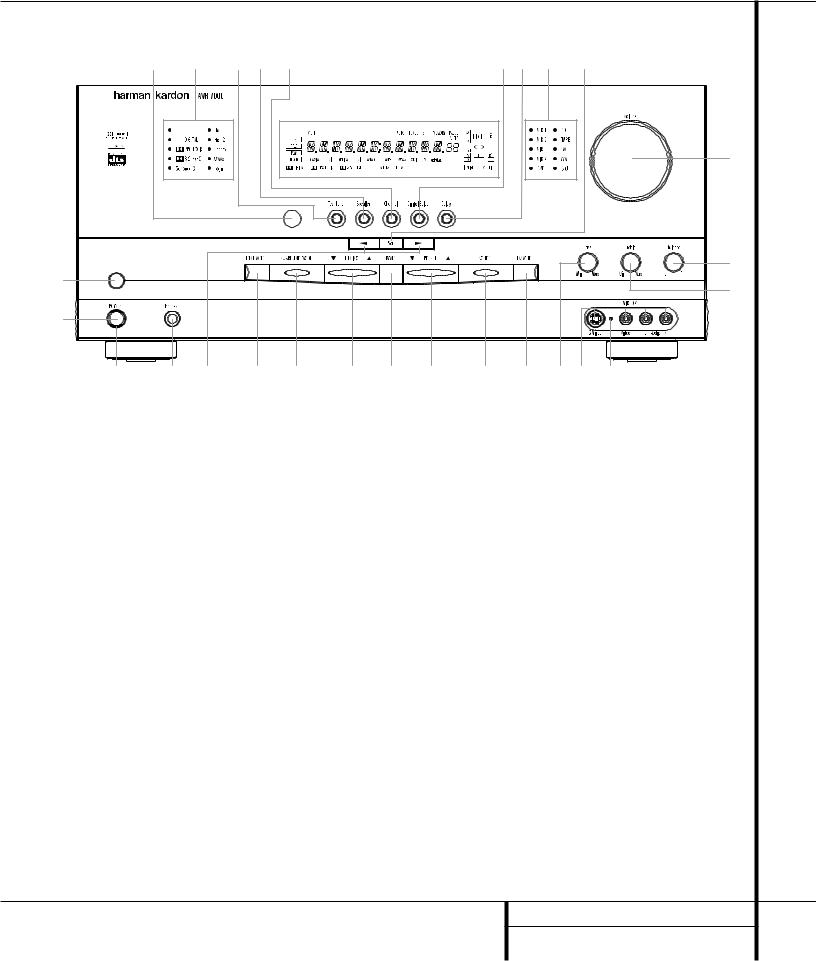
Front Panel Controls
ˆı ÙÛ Ú |
Ò |
Ô Ó ( |
|||||||
|
|
|
|
|
|
|
|
|
|
|
|
|
|
|
|
|
|
|
|
|
|
|
|
|
|
|
|
|
|
|
|
|
|
|
|
|
|
|
|
|
|
|
|
|
|
|
|
|
|
|
|
|
|
|
|
|
|
|
|
*
|
& |
1 |
^ |
|
|
2 |
|
3 4 5 6 7 8 9 ) ! @ #$ %
1 Main Power Switch
2 System Power Control
3 Power Indicator
4 Headphone Jack
5 Selector Buttons
6 Tone Mode
7 Surround Mode Selector
8 Tuning Selector
9 Tuner Band Selector
)Preset Stations Selector
1 Main Power Switch: Press this button to apply power to the AVR 7000. When the switch is pressed in, the unit is placed in a Standby mode, as indicated by the amber LED
3surrounding the System Power Control
2. This button MUST be pressed in to operate the unit. To turn the unit off and prevent the use of the remote control, this switch should be pressed until it pops out from the front panel so that the word “OFF” may be read at the top of the switch.
NOTE: In normal operation this switch is left in the “ON” position.
2 System Power Control: When the Main Power Switch 1is “ON,” press this button
! Input Source Selector
@ FM Mode Selector
# Bass Control
$ Video 4 Input Jacks
% Video 4 Status Indicator
^ Treble Control
& Balance Control
* Volume Control
( Set Button
Ó Input Indicators
to turn on the AVR 7000; press it again to turn the unit off. Note that the Power Indicator surrounding the switch 3will turn green when the unit is on.
3 Power Indicator: This LED will illuminate in amber when the unit is in the Standby mode to signal that the unit is ready to be turned on. When the unit is in operation, the indicator will turn green.
4Headphone Jack: This jack may be used to listen to the AVR 7000’s output through a pair of headphones. Be certain that the headphones have a standard 1/4" stereo phone plug. Note that the main room speakers will automatically be turned off when the headphone jack is in use.
Ô Delay
Digital Input Selector
Ò Information Display
Ú Channel Select Button
Û Speaker Select Button
Ù Test Tone Selector
ı Surround Mode Indicators
ˆ Remote Sensor Window
5 Selector Buttons: When you are establishing the AVR 7000’s configuration settings, use these buttons to select from the choices available, as shown in the Information Display Ò.
6Tone Mode: Pressing this button enables or disables the Bass and Treble tone controls. When the button is pressed so that the words TONE IN appear in the Main Information Display Ò, the settings of the Bass #and Treble ^controls will affect the output signals. When the button is pressed so that the words TONE OUT appear in the Main Information Display Ò, the output signal will be “flat,” without any bass or treble alteration.
5 FRONT PANEL CONTROLS

Front Panel Controls
7Surround Mode Selector: Press this button to change the surround mode by scrolling through the list of available modes. Note that depending on the type of input, some modes are not always available. (See page 25 for more information about surround modes.)
8Tuning Selector: Press the left side of the button to tune lower frequency stations and the right side of the button to tune higher frequency stations. When a station with a strong signal is reached, the TUNED indicator Uwill illuminate in the Information Display Ò .
To tune manually, tap the button lightly and note that the tuner will step up one frequency increment per button press. When the button is held for a few seconds you will note that the unit will quickly search the frequency band. Release it once the fast tuning starts and the tuner will automatically scan for the next station with an acceptable signal and then stop.
9Tuner Band Selector: Pressing this button will automatically switch the AVR to the Tuner mode. Pressing it again will switch between the AM and FM frequency bands. (See page 29 for more information on the tuner.)
) Preset Stations Selector: Press this button to select stations that have been entered into the preset memory. (See page 29 for more information on tuner programming.)
!Input Source Selector: Press this button to change the input by scrolling through the list of input sources.
@FM Mode Selector: Press this button to select Auto or Manual tuning. When the button is pressed so that the AUTO Indicator Vlights, the tuner will search for the next station with an acceptable signal when the Tuning Selector 8xéis pressed. When the button is pressed so that the AUTO Indicator Vis not lit, each press of the Tuning Selector 8xé will increase the frequency. (See page 29 for more information on using the tuner.)
#Bass Control: Turn this control to modify the low frequency output of the left/right channels by as much as ±10dB. Set this control to a suitable position for your taste or room acoustics.
$Video 4 Input Jacks: These audio/video jacks may be used for temporary connection to video games or portable audio/video products such as camcorders and portable audio players.
In normal use, they are an input that may be selected by pressing the Input Source Selector !on the front panel, or the Video 4 Selector on either remote mç. These jacks may also be configured as an audio/video output, that will make a dub of the currently selected source when connected to an external recorder or camcorder. To change the jacks from their default setting as an input to an output, use the Advanced Menu in the OSD system. (See page 31 for more information on using the Video 4 jacks as a record output.)
%Video 4 Status Indicator: This indicator will normally be green to show that the Video 4 jacks are operating as an input source. When the jacks have been configured as an output, the indicator will turn red to show that they are being used for recording. (See page 31 for more information on using the Video 4 jacks.)
^Treble Control: Turn this control to modify the high frequency output of the left/right channels by as much as ±10dB. Set this control to a suitable position for your taste or room acoustics.
& Balance Control: Turn this control to change the relative volume for the front left/right channels.
NOTE: For proper operation of the surround modes this control should be at the midpoint or “12 o’clock” position.
*Volume Control: Turn this knob clockwise to increase the volume, counterclockwise to decrease the volume. If the AVR is muted, adjusting volume control will automatically release the unit from the silenced condition.
(Set Button: When making choices during the setup and configuration process, press this button to enter the desired setting as shown in the Information Display Òinto the AVR 7000’s memory. The set button may also be used to change the display brightness. (See page 31.)
ÓInput indicators: A green LED will light in front of the input that is currently being used as the source for the AVR 7000.
Ô Delay: Press this button to begin the sequence of steps required to enter delay time settings. (See pages 20–21 for more information on delay times.)
Digital Input Selector: When playing a source that has a digital output, press this button to select between the Optical · and Coaxial ° Digital inputs. (See pages 27–29 for more information on digital audio.)
Ò Information Display: This display delivers messages and status indications to help you operate the receiver. (See pages 7–8 for a complete explanation of the Information Display.)
ÚChannel Select Button: Press this button to begin the process of trimming the channel output levels using an external audio source. (For more information on output level trim adjustment, see page 29.)
ÛSpeaker Select Button: Press this button to begin the process of selecting the speaker positions that are used in your listening room. (See page 22 for more information on setup and configuration.)
ÙTest Tone Selector: Press this button to begin the process of adjusting the channel output levels using the internal test tone as a reference. (For more information on output level adjustment, see page 23.)
ı Surround Mode Indicators: A green LED will light in front of the surround mode that is currently in use.
ˆ Remote Sensor Window: The sensor behind this window receives infrared signals from the remote control. Aim the remote at this area and do not block or cover it unless an external remote sensor is installed.
6 FRONT PANEL CONTROLS
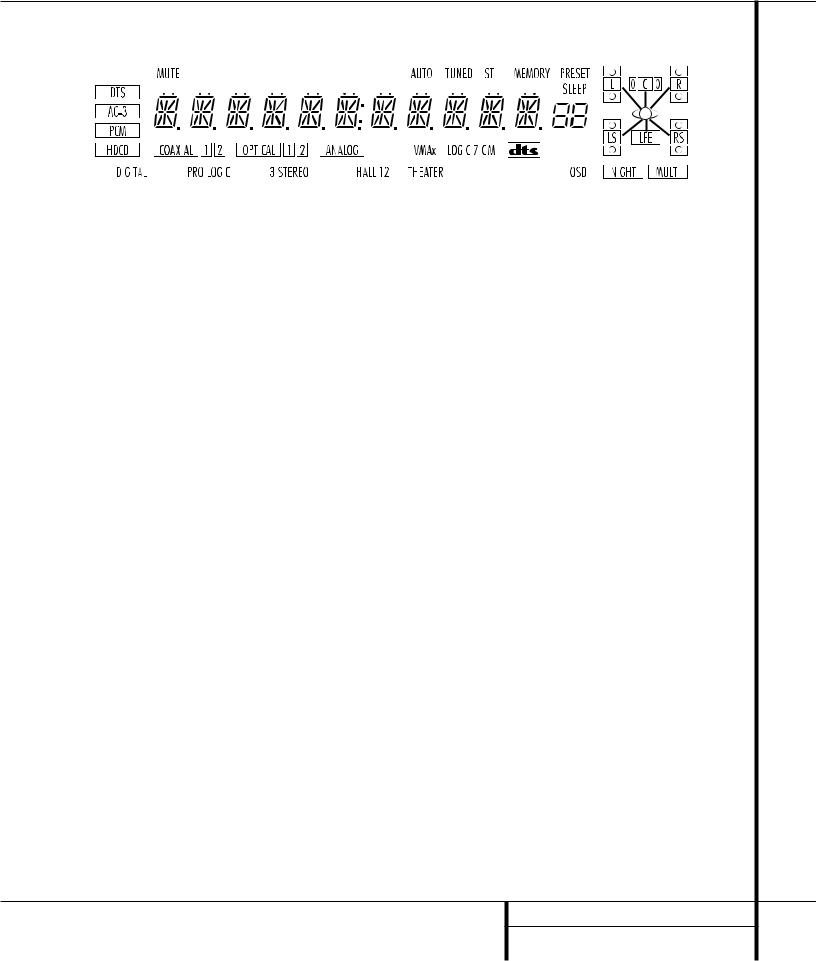
Front Panel Information Display
|
|
|
|
|
|
|
|
|
|
X |
|
|
|
|
|
|
|
|
|
|
|
|
|
|
|
|
|
|
|
W |
V U T |
|
S |
R Q |
|||||||||||||||||||||||||||
A |
|
|
|
|
|
|
|
|
|
|
|
|
|
|
|
|
|
|
|
|
|
|
|
|
|
|
|
|
|
|
|
|
|
|
|
|
|
|
|
|
|
|
|
|
|
|
|
|
|
|
|
|
|
|
|
|
|
|
|
|
P |
|
|
|
|
|
|
|
|
|
|
|
|
|
|
|
|
|
|
|
|
|
|
|
|
|
|
|
|
|
|
|
|
|
|
|
|
|
|
|
|
|
|
|
|
|
|
|
|
|
|
|
|
|
|
|
|
|
|
|
|
||
|
|
|
|
|
|
|
|
|
|
|
|
|
|
|
|
|
|
|
|
|
|
|
|
|
|
|
|
|
|
|
|
|
|
|
|
|
|
|
|
|
|
|
|
|
|
|
|
|
|
|
|
|
|
|
|
|
|
|
|
||
|
|
|
|
|
|
|
|
|
|
|
|
|
|
|
|
|
|
|
|
|
|
|
|
|
|
|
|
|
|
|
|
|
|
|
|
|
|
|
|
|
|
|
|
|
|
|
|
|
|
|
|
|
|
|
|
|
|
|
|
||
|
|
|
|
|
|
|
|
|
|
|
|
|
|
|
|
|
|
|
|
|
|
|
|
|
|
|
|
|
|
|
|
|
|
|
|
|
|
|
|
|
|
|
|
|
|
|
|
|
|
|
|
|
|
|
|
|
|
|
|
||
|
|
|
|
|
|
|
|
|
|
|
|
|
|
|
|
|
|
|
|
|
|
|
|
|
|
|
|
|
|
|
|
|
|
|
|
|
|
|
|
|
|
|
|
|
|
|
|
|
|
|
|
||||||||||
|
|
|
|
|
|
|
|
|
|
|
|
|
|
|
|
|
|
|
|
|
|
|
|
|
|
|
|
|
|
|
|
|
|
|
|
|
|
|
|
|
|
|
|
|
|
|
|
|
|
|
|
|
|
|
|
|
|
|
|
|
|
|
|
|
|
|
|
|
|
|
|
|
|
|
|
|
|
|
|
|
|
|
|
|
|
|
|
|
|
|
|
|
|
|
|
|
|
|
|
|
|
|
|
|
|
|
|
|
|
|
|
|
|
|
|
|
|
|
|
|
|
|
|
|
|
|
|
|
|
|
|
|
|
|
|
|
|
|
|
|
|
|
|
|
|
|
|
|
|
|
|
|
|
|
|
|
|
|
|
|
|
|
|
|
|
|
|
|
|
|
|
|
|
|
|
|
|
|
|
|
|
|
|
|
|
|
|
|
|
|
|
|
|
|
|
|
|
|
|
|
|
|
|
|
|
|
|
|
|
|
|
|
|
|
|
|
|
|
|
|
|
|
|
|
|
|
|
|
|
|
|
|
|
|
|
|
|
|
|
|
|
|
|
|
|
|
|
|
|
|
|
|
|
|
|
|
|
|
|
|
|
|
|
|
|
|
|
|
|
|
|
|
|
|
|
|
|
|
|
|
|
|
|
|
|
|
|
|
|
|
|
|
|
|
|
|
|
|
|
|
|||||||||
|
|
|
|
|
|
|
|
|
|
|
|
|
|
|
|
|
|
|
|
|
|
|
|
|
|
|
|
|
|
|
|
|
|
|
|
|
|
|
|
|
|
|
|
|
|
|
|
|
|
|
|
|
|
||||||||
|
|
|
|
|
|
|
|
|
|
|
|
|
|
|
|
|
|
|
|
|
|
|
|
|
|
|
|
|
|
|
|
|
|
|
|
|
|
|
|
|
|
|
|
|
|
|
|
|
|
|
|
|
|
|
|
|
|
|
|
|
|
|
|
|
|
|
B C |
|
|
|
|
|
|
D |
|
|
|
|
|
|
|
E F G H I J K L M N O |
|||||||||||||||||||||||||||||||||||||||||
A Bitstream Indicators |
|
|
|
|
|
|
|
|
|
|
|
|
|
|
I Theater Mode Indicator |
|
|
|
|
|
|
|
|
Q Sleep Indicator |
|||||||||||||||||||||||||||||||||||||
B Dolby Digital Indicator |
|
|
|
|
|
|
|
|
|
|
|
|
|
|
J Logic 7 Mode Indicators |
|
|
|
|
|
|
|
|
R Preset Indicator |
|||||||||||||||||||||||||||||||||||||
C Coaxial Source Indicators |
|
|
|
|
|
|
|
|
|
|
|
|
|
|
K DTS Mode Indicator |
|
|
|
|
|
|
|
|
S Memory Indicator |
|||||||||||||||||||||||||||||||||||||
D Analog Dolby Surround Mode Indicators |
|
|
|
L Preset Number/Sleep Timer |
T Stereo Indicator |
||||||||||||||||||||||||||||||||||||||||||||||||||||||||
E Optical Source Indicators |
|
|
|
|
|
|
|
|
|
|
|
|
|
|
M OSD Indicator |
|
|
|
|
|
|
|
|
U Tuned Indicator |
|||||||||||||||||||||||||||||||||||||
F Analog Input Indicator |
|
|
|
|
|
|
|
|
|
|
|
|
|
|
N Night Mode Indicator |
|
|
|
|
|
|
|
|
V Auto Indicator |
|||||||||||||||||||||||||||||||||||||
G Hall Mode Indicators |
|
|
|
|
|
|
|
|
|
|
|
|
|
|
O Multiroom Indicator |
|
|
|
|
|
|
|
|
W Main Information Display |
|||||||||||||||||||||||||||||||||||||
H VMAx Mode Indicator |
|
|
|
|
|
|
|
|
|
|
|
|
|
|
P Speaker/Channel Input Indicators |
X Mute Indicator |
|||||||||||||||||||||||||||||||||||||||||||||
ABitstream™ Indicators: When the selected input is a digital source, one of these indicators will light to display the specific type of signal in use.
B Dolby Digital Indicator: This indicator illuminates when a Dolby Digital source is being played.
C Coaxial Source Indicators: These indicators light to show when one of the two Coaxial Digital Inputs has been selected.
DAnalog Dolby Surround Mode Indicators: These indicators illuminate when one of the analog (matrix) Dolby Surround modes is in use.
EOptical Source Indicators: These indicators light to show when one of the two Optical Digital Inputs has been selected.
FAnalog Input Indicator: This indicator lights when an analog input source has been selected.
G Hall Mode Indicators: These indicators light when one of the Hall modes has been selected.
HVMAx Mode Indicator: This indicator illuminates to show that the VMAx mode is in use.
ITheater Mode Indicator: This indicator illuminates to show that the Theater mode is in use.
J Logic 7 Mode Indicators: These indicators illuminate when the Logic 7 mode is in use. LOGIC 7C appears for the Cinema ver-
sion of Logic 7, LOGIC 7M appears for the Music version of Logic 7.
K DTS Mode Indicator: This indicator illuminates when a DTS-encoded source is playing.
LPreset Number/Sleep Timer: When the tuner is in use, these numbers indicate the specific preset memory location in use. (See page 29 for more information on preset stations.) When the Sleep function is in use, these numbers show how many minutes remain before the unit goes into the Standby mode.
MOSD Indicator: When the OSD system is in use, this indicator lights to remind you that the other indicators in this display do not function when the On Screen Display is being used.
N Night Mode Indicator: This indicator lights when the AVR 7000 is in the Night mode, which preserves the dynamic range of digital program material at low volume levels.
O Multiroom Indicator: This indicator lights when the multiroom system is active. Note that it will remain lit when the multiroom system is in use even though the main room system is in the Standby mode and all other indicators are dark. (See page 33 for more information on the Multiroom system.)
PSpeaker/Channel Input Indicators: These indicators are multipurpose, indicating either the speaker type selected for each channel or the incoming data-signal configuration. The left, center, right, right surround and left surround
speaker indicators are composed of three boxes, while the subwoofer is a single box. The center box lights when a “Small” speaker is selected, and the two outer boxes light when “Large” speakers are selected. When none of the boxes are lit for the center, surround or subwoofer channels, no speaker has been selected for that position. (See page 22 for more information on configuring speakers.) The letters inside each of the center boxes display active input channels. For standard analog inputs, only the L and R will light, indicating a stereo input. When a digital source is playing, the indicators will light to display the channels begin received at the digital input. When the letters flash, the digital input has been interrupted. See page 28 for more information on the Channel Indicators.
Q Sleep Indicator: This indicator lights when the Sleep function is in use. The numbers in the Preset/Sleep Number Indicators will show the minutes remaining before the AVR 7000 goes into the Standby mode. (See page 25 for more information on the Sleep function.)
R Preset Indicator: This indicator lights when the tuner in use to show that the Preset Number/Sleep Timer Lis showing the station’s preset memory number. (See page 29 for more information on tuner presets.)
S Memory Indicator: This indicator flashes when entering presets and other information into the tuner’s memory.
7 FRONT PANEL INFORMATION DISPLAY
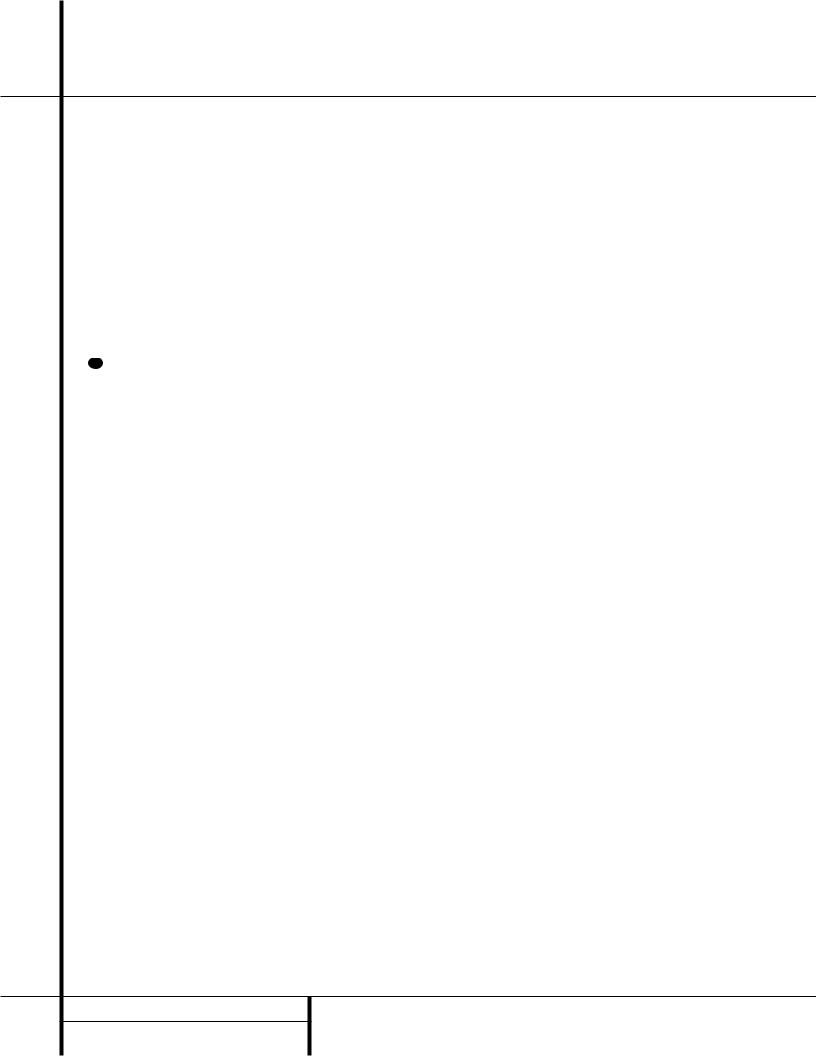
Front Panel Information Display
TStereo Indicator: This indicator illuminates when an FM station is being tuned in stereo.
UTuned Indicator: This indicator illuminates when a station is being received with sufficient signal strength to provide acceptable listening quality.
VAuto Indicator: This indicator illuminates when the tuner’s Auto mode is in use.
W Main Information Display: This display shows messages relating to the status, input source, surround mode, tuner, volume level or other aspects of unit’s operation.
X Mute Indicator: This indicator illuminates to remind you that the AVR 7000’s output has been silenced by pressing the Mute button f
I . Press the Mute button again to return to the previously selected output level.
8 FRONT PANEL INFORMATION DISPLAY
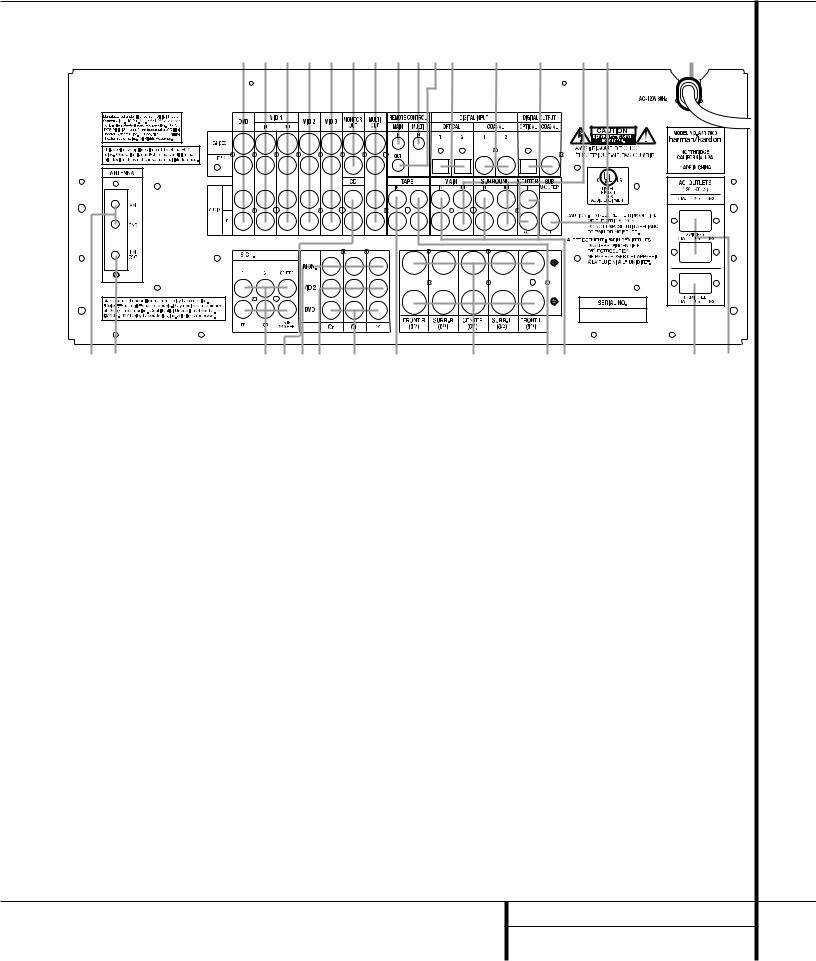
Rear Panel Connections
j i h g f e d cba· ° ‡ fl fi ›
- 



¡ ™ |
£¢ § ¶ • ª ‚⁄ |
¤ ‹ |
||
¡ AM Antenna |
⁄ Amplifier Inputs |
b Multiroom IR Input |
|
|
™ FM Antenna |
¤ Unswitched AC Accessory Outlet |
c Remote IR Input |
|
|
£ 6-Channel Direct Inputs |
‹ Switched AC Accessory Outlets |
d Multiroom Outputs |
|
|
¢ CD Inputs |
› AC Power Cord |
e Video Monitor Outputs |
|
|
Component Video Outputs |
fi Subwoofer Output |
f Video 3 |
Inputs |
|
§ Video 2 Component Video Inputs |
fl Preamp Outputs |
g Video 2 |
Inputs |
|
¶ DVD Component Video Inputs |
‡ Digital Audio Outputs |
h Video 1 |
Outputs |
|
• Tape Inputs |
° Coaxial Digital Inputs |
i Video 1 |
Inputs |
|
ª Speaker Outputs |
· Optical Digital Inputs |
j DVD Inputs |
|
|
‚ Tape Outputs |
a Remote IR Output |
|
|
|
NOTE: For all video inputs and outputs f g h i j, the same number is used to indicate the audio, composite-video and S-Video connections related to that input. This accounts for the same number appearing in more than one place on the rear-panel drawing.
9 REAR PANEL CONNECTIONS

Rear Panel Connections
¡AM Antenna: Connect the AM loop antenna supplied with the receiver to these terminals. If an external AM antenna is used, make connections to the AM and GND terminals in accordance with the instructions supplied with the antenna.
™ FM Antenna: Connect the supplied indoor or the optional external FM antenna to this terminal.
£ 6-Channel Direct Inputs: If an external digital audio decoder is used, connect the outputs of that decoder to these jacks.
¢ CD Inputs: Connect these jacks to the output of a compact disc player or CD changer.
Component Video Outputs: Connect these outputs to the component video inputs of a video projector or monitor. When a source connected to one of the two Component Video Inputs §¶ is selected the signal will be sent to these jacks.
§ Video 2 Component Video Inputs:
Connect the Y/Cr/Cb component video outputs of a set top converter box or other video product to these jacks.
¶ DVD Component Video Inputs: Connect the Y/Cr/Cb component video outputs of a DVD player to these jacks.
• Tape Inputs: Connect these jacks to the PLAY/OUT jacks of an audio recorder.
ª Speaker Outputs: Connect the these jacks to the matching + or – terminals on your speakers. When making speaker connections, always make certain to maintain correct polarity by connecting the red (+) terminals on the AVR to the red terminals on the speaker and the black (–) terminals on the AVR to the black terminals on the speakers. (See page 15 for more information on speaker polarity.)
‚ Tape Outputs: Connect these jacks to the RECORD/INPUT jacks of an audio recorder.
⁄ Amplifier Inputs: When the jumper pins that link the Preamp Outputs fl with these inputs are removed, these jacks may be used to connect an external source or the AVR7000’s multiroom system to the internal amplifiers. (See page 17 for more information on using these connections.)
¤ Unswitched AC Accessory Outlet: This outlet may be used to power any AC device. The power will remain on at this outlet regardless of whether the AVR 7000 is on or off.
‹ Switched AC Accessory Outlets: These outlets may be used to power any device that you wish to have turn on when the unit is turned on with the System Power Control switch 2.
› AC Power Cord: Connect the AC plug to an unswitched AC wall output.
fi Subwoofer Output: Connect this jack to the line-level input of a powered subwoofer. If an external subwoofer amplifier is used, connect this jack to the subwoofer amplifier input.
fl Preamp Outputs: When the jumper pins that link the Amplifier Inputs ⁄ with these outputs are removed, these jacks may be connected to an external power amplifier.
‡ Digital Audio Outputs: Connect these jacks to the matching digital input connector on a digital recorder such as a CD-R or MiniDisc recorder.
° Coaxial Digital Inputs: Connect the coax digital output from a DVD player, HDTV receiver, LD player or CD player to these jacks. The signal may be either a Dolby Digital signal, DTS signal or a standard PCM digital source.
· Optical Digital Inputs: Connect the optical digital output from a DVD player, HDTV receiver, LD player or CD player to these jacks. The signal may be either a Dolby Digital signal, a DTS signal or a standard PCM digital source.
a Remote IR Output: This connection permits the IR sensor in the receiver to serve other remote controlled devices. Connect this jack to the “IR IN” jack on Harman Kardon or other compatible equipment.
b Multiroom IR Input: Connect the output of an IR sensor in a remote room to this jack to operate the AVR 7000’s multiroom control system.
c Remote IR Input: If the AVR 7000’s front-panel IR sensor is blocked due to cabinet doors or other obstructions, an external IR
sensor may be used. Connect the output of the sensor to this jack.
d Multiroom Outputs: Connect these jacks to the optional audio power amplifiers or video display devices to view and listen to the source selected by the mulitroom system in a remote room.
e Video Monitor Outputs: Connect this jack to the composite or S-Video input of a TV monitor or video projector to view the on-screen menus and the output of any standard video source selected by the receiver’s video switcher.
f Video 3 Inputs: Connect these jacks to the audio and video outputs of a TV tuner, Cable TV converter box, satellite receiver or another audio/video source.
g Video 2 Inputs: Connect these jacks to the audio and video outputs of a TV Tuner, Cable TV converter box, satellite receiver or any other audio/video source.
hVideo 1 Outputs: Connect these jacks to the audio and video RECORD/INPUT jacks of a VCR.
i Video 1 Inputs: Connect these jacks to the audio and video PLAY/OUT jacks of a VCR.
j DVD Inputs: Connect the analog audio outputs and composite video output of a DVD or LD player to these jacks.
10 REAR PANEL CONNECTIONS
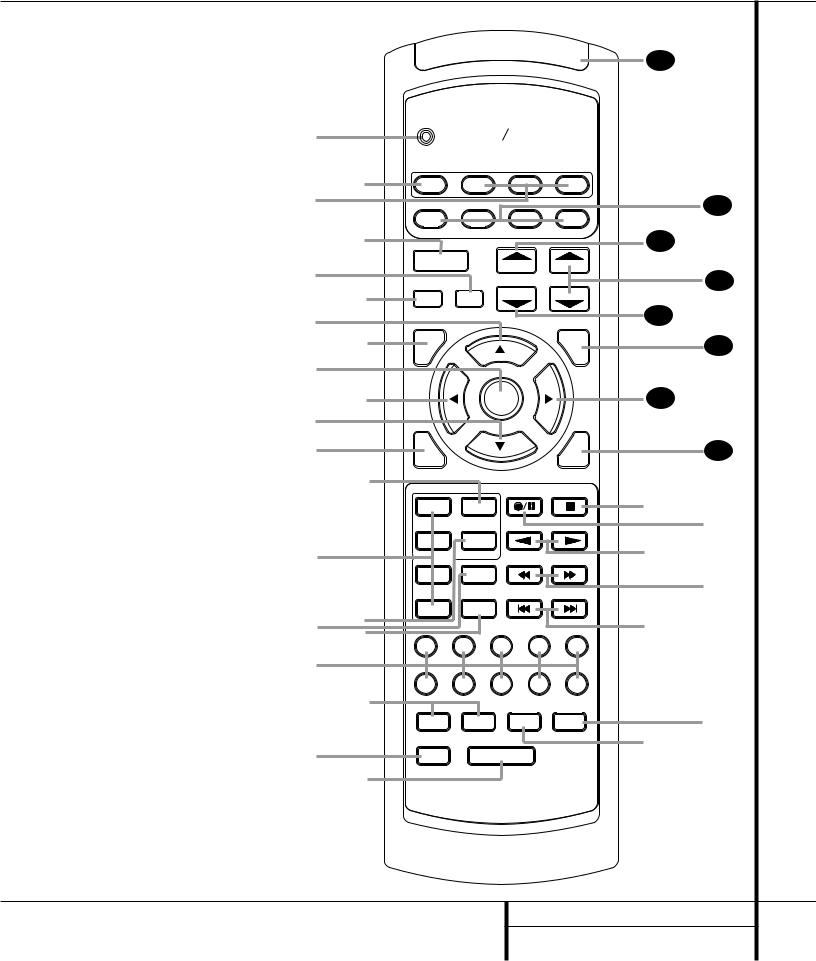
Main Remote Control Functions |
|
|
|
|
|
|
|
|
a Program Indicator |
|
|
|
|
|
|
|
|
b AVR Selector |
|
|
|
|
|
|
|
35 |
c CD/Tape/DVD Input Selectors |
|
|
|
|
|
|
|
|
d Power Off Button |
|
|
|
|
|
|
|
|
e Test Tone |
|
|
|
|
|
|
|
|
f Mute |
|
|
|
|
|
|
|
|
g ⁄/¤ Buttons |
a |
|
|
harman kardon |
|
|||
h Channel Select Button |
|
|
|
|||||
i Set Button |
|
|
|
|
|
|
|
|
j ‹ Button |
|
|
ON |
|
|
|
|
|
k Digital Select |
|
b |
AVR |
CD |
TAPE |
|
DVD |
|
l 6-Ch. Direct Input |
c |
|
34 |
|||||
|
|
|
|
|
|
|||
m Video Input Selectors |
|
SAT |
TV |
VCR |
|
CBL |
||
n AM/FM Tuner Select |
|
|
|
|
||||
|
d |
|
|
|
|
|
33 |
|
o Tuner Mode |
|
|
|
|
|
|
||
|
|
|
|
|
|
|
|
|
pMemory Button |
|
|
POWER |
SLEEP |
|
|
|
|
q Numeric Keys |
e |
|
|
|
|
|||
|
|
|
|
|
32 |
|||
r Macro 1/2 Buttons |
|
|
T/V |
CH. |
|
VOL. |
||
s OSD Button |
|
f |
MUTE |
TEST |
SURR. |
|
|
|
|
|
|
|
31 |
||||
t Light Button |
g |
|
GUIDE |
|
|
|
MENU |
|
u Direct/Macro 3 Button |
|
|
|
|
||||
h |
|
|
|
30 |
||||
v Clear/Macro 4 Button |
|
CH. |
|
|
|
SPKR |
||
|
|
|
|
|
|
|||
|
|
|
|
|
|
|
|
|
w Preset Up/Down |
i |
|
|
|
|
|
|
|
x Tuning Up/Down |
|
|
|
|
|
|
|
|
y Forward/Reverse Transport Buttons |
|
j |
|
|
|
|
|
29 |
z Night Mode |
g |
|
|
SET |
|
|
||
` Multi-Room |
|
|
|
|
|
|
|
|
|
|
|
|
|
|
|
|
|
●28 Delay/Prev. Ch. |
|
|
|
|
|
|
|
|
●29 › Button |
k |
|
|
|
|
|
|
28 |
●30 Speaker Select |
|
DIGITAL |
|
|
|
DELAY |
||
|
|
|
|
|
|
|||
●31 Surround Mode Selector |
|
l |
EXIT |
|
|
|
PREV.CH. |
|
32 Volume Up/Down |
|
|
|
NIGHT |
|
MULTI-ROOM |
|
|
● |
|
|
|
|
|
` |
||
●33 Sleep Button |
|
|
VID 1 |
6 CH. |
|
|
|
|
●34 Video Remote Selectors |
|
|
|
|
|
|
|
z |
●35 IR Transmitter Window |
|
|
VID 2 |
AM/FM |
|
|
|
y |
|
|
|
|
|
|
|||
|
m |
|
|
|
DWN-TUNING-UP |
|||
NOTE: The function names shown here are each |
|
|
|
|
||||
|
|
VID 3 |
TUN-M |
|
|
|
x |
|
button’s feature when used with the AVR. Most |
|
|
|
|
DWN-PRESET-UP |
|||
buttons have additional functions when used |
|
n |
VID 4 |
MEMORY |
|
|
|
|
with other devices. See page 38 for a list of |
o |
|
|
|
|
|
w |
|
these functions. |
p |
1 |
2 |
3 |
4 |
5 |
||
|
|
|
||||||
|
q |
|
|
|
|
|
|
|
|
|
|
6 |
7 |
8 |
9 |
0 |
|
|
|
r |
|
|
DIRECT |
CLEAR |
v |
|
|
|
|
M1 |
M2 |
M3 |
|
M4 |
|
|
s |
|
OSD |
LIGHT |
|
|
u |
|
|
|
|
|
|
||||
|
|
t |
|
AVR 7000 |
|
|
|
|
|
|
|
|
|
|
|
||
|
|
|
|
|
11 MAIN REMOTE CONTROL FUNCTIONS |
|||
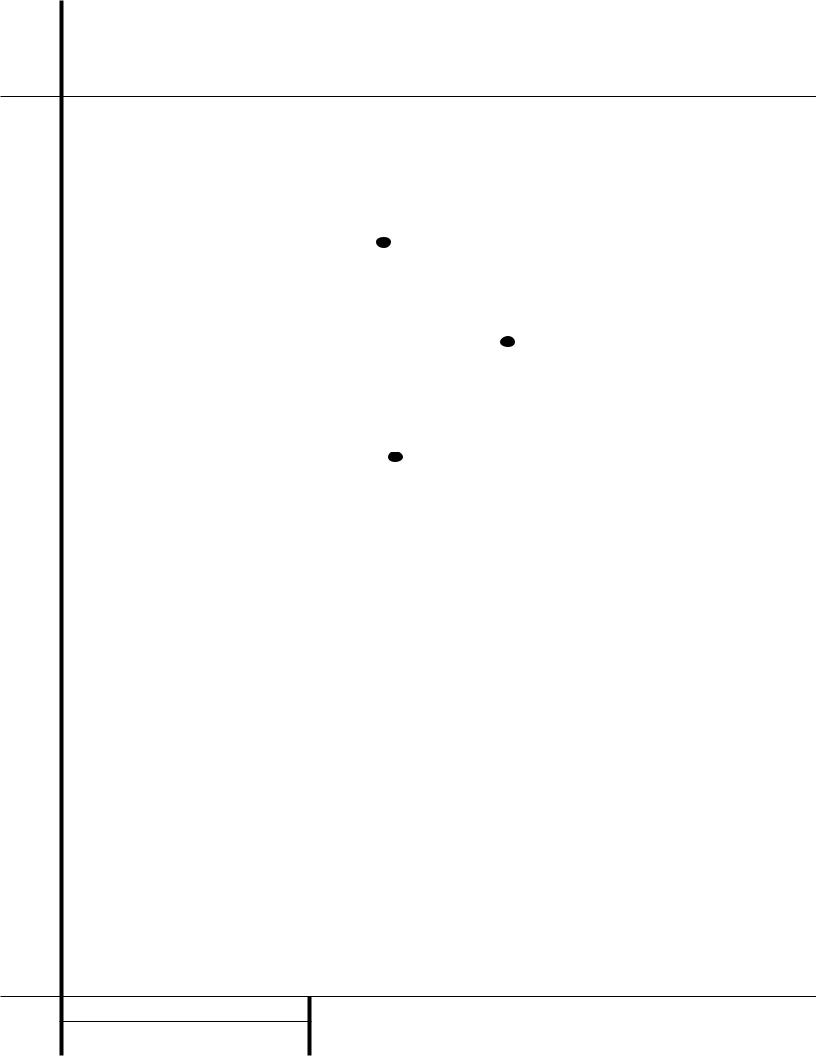
Main Remote Control Functions
IMPORTANT NOTE: The AVR 7000’s remote may be programmed to control up to eight devices, including the AVR 7000. Before using the remote, it is important to remember to press the Device Control Selector button b c that corresponds to the unit you wish to operate. In addition, the AVR 7000’s remote
is shipped from the factory to operate the
AVR 7000 and most Harman Kardon CD or DVD players and cassette decks. The remote is also capable of operating a wide variety of other products using the control codes that are part of the remote. Before using the remote with other products, follow the instructions on pages 34–45 to program the proper codes for the products in your system.
It is also important to remember that many of the buttons on the remote take on different functions, depending on the product selected using the Device Control Selectors. The descriptions shown here primarily detail the functions of the remote when it is used to operate the AVR 7000. (See page 38 for information about alternate functions for the remote’s buttons.)
aProgram Indicator: This three-color indicator is used to guide you through the process of learning commands from a remote into the AVR’s remote code memory. (See page 35 for information on learning IR codes.)
bAVR Selector: Pressing this button will switch the remote so that it will operate the AVR’s functions. If the AVR is in the Standby mode, it will also turn the AVR on.
cCD/Tape/DVD Input Selectors: Pressing one of these buttons will perform three actions at the same time. First, if the AVR is not turned on, this will power up the unit. Next, it will select the source shown on the button as the input to the AVR. Finally, it will change the remote control so that it controls the device selected. After pressing one of these buttons you must press the AVR Selector button b again to operate the AVR’s functions with the remote.
d Power Off Button: Press this button to place the unit in the Standby mode. Note that this will turn off the main room functions, but if the Multiroom system is activated, it will continue to function.
eTest Tone: Press this button to begin the sequence used to calibrate the AVR 7000’s output levels. (See page 23 for more information on calibrating the AVR 7000.)
fMute: Press this button to momentarily silence the AVR 7000 or TV set being controlled, depending on which device has been selected.
When the AVR 7000 remote is being programmed to operate another device, this button is pressed with the Device Control Selector button b 34 to begin the programming
process. (See page 34 for more information on programming the remote.)
g ⁄/¤ Buttons: These are multi-purpose buttons. They will be used most frequently to select a surround mode. To change the surround mode, first press the SURR/CH ¤ button 31 .
Next press these buttons to scroll up or down through the list of surround modes that appear in the Information Display 23.. These buttons are also used to increase or decrease output levels when configuring the unit with either the internal test tone or an external source. They are also used to enter delay time settings after the Delay button 28 has been pressed.
h Channel Select Button: This button is used to start the process of setting the AVR 7000’s output levels to an external source. Once this button is pressed, use the ⁄/¤ buttons g to select the channel being adjusted, then press the Set button i, followed by the ⁄/¤ buttons again, to change the level setting. (See page 23 for more information.)
i Set Button: This button is used to enter settings into the AVR 7000’s memory. It is also used in the setup procedures for delay time, speaker configuration and channel output level adjustment.
j ‹ Button: This button is used to change the menu selection or setting during some of the setup procedures for the AVR.
k Digital Select: Press this button to assign one of the digital inputs ° · to a source. (See page 27 for more information on using digital inputs.)
l 6-Ch. Direct Input: Press this button to select the component connected to the 6-Ch. direct Input £ as the source
m Video Input Selector: Press one of these buttons to select a video input as the listening and viewing source.
nAM/FM Tuner Select: Press this button to select the AVR’s tuner as the listening choice.
Pressing this button when a tuner is in use will select between the AM and FM bands.
oTuner Mode: Press this button when the tuner is in use to select between automatic tuning and manual tuning. When the button is pressed so that the AUTO indicator Vgoes out, pressing the Tuning buttons x8 will move the frequency up or down in singlestep increments. When the FM band is in use, pressing this button when a station’s signal is weak will change to monaural reception. (See page 29 for more information.)
pMemory Button: Press this button to enter a radio station into the AVR 7000’s preset memory. After pressing the button the MEMORY indicator Swill flash; you then have five seconds to enter a preset memory location using the Numeric Keys q. (See page 29 for more information.)
q Numeric Keys: These buttons serve as a ten-button numeric keypad to enter tuner preset positions. They are also used to select channel numbers when TV has been selected on the remote, or to select track numbers on a CD, DVD or LD player, depending on how the remote has been programmed.
r Macro 1/2 Buttons: These buttons are used to recall or enter the programming sequence for a preprogrammed Macro sequence. (See page 36 for more information on programming and using Macros.)
s OSD Button: Press this button to activate the On Screen Display (OSD) system used to set up or adjust the AVR 7000’s parameters.
t Light Button: Press this button to activate the remote’s built-in backlight for better legibility of the buttons in a darkened room.
u Direct/Macro 3 Button: This button has two functions. Pressing it when the tuner is in use will start the sequence for direct entry of a station’s frequency. After pressing the button simply press the proper Numeric Keys qto select a station. This button may also be used to store or recall a macro sequence. (See page 29 for more information on the tuner, and page 36 for more information on programming and using Macros.).
v Clear/Macro 4 Button: This button may be used to store and recall a macro; it may also be programmed for use with other devices. (See page 36 for nore information on macros.)
12 MAIN REMOTE CONTROL FUNCTIONS
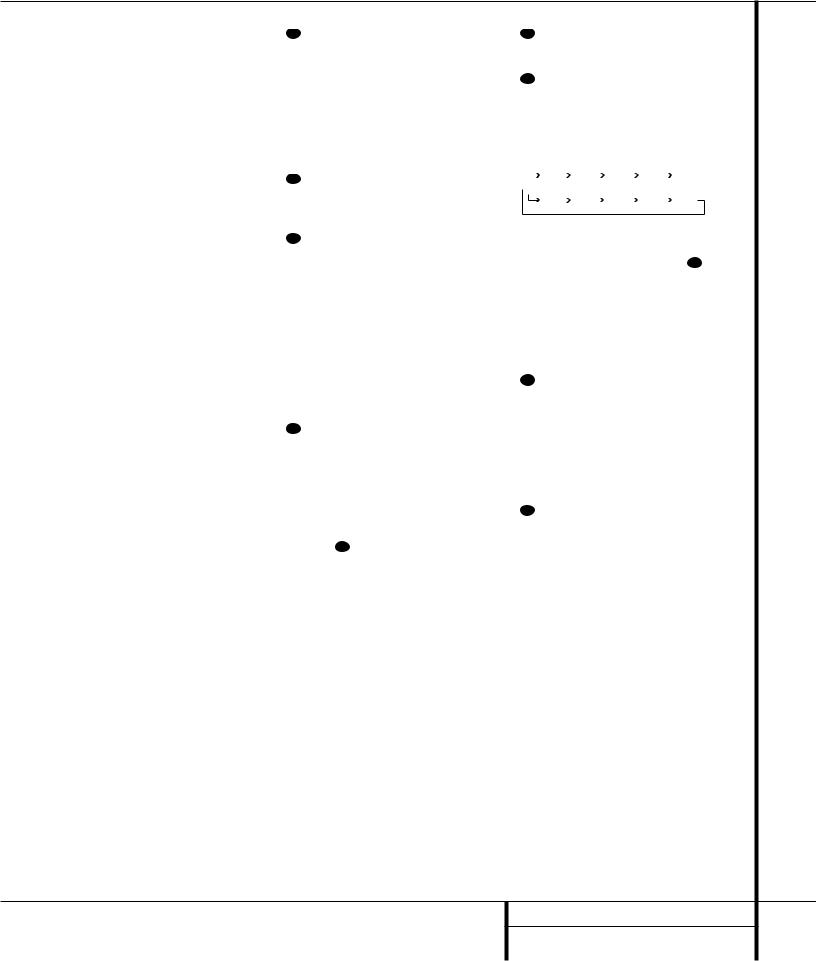
Main Remote Control Functions
w Preset Up/Down: When the tuner is
in use, press these buttons to scroll through the stations programmed into the AVR 7000’s memory. When some source devices, such as CD players, VCRs and cassette decks, are selected using the Device Control Selectors cç, these buttons may function as chapter step or track advance.
xTuning Up/Down: When the tuner is in use, these buttons will tune up or down through the selected frequency band. If the Tuner Mode button o@has been pressed so that the AUTO indicator Vis illuminated, pressing and holding either of the buttons for three seconds will cause the tuner to seek the next station with acceptable signal strength for quality reception. When the AUTO indicator Vis NOT illuminated, pressing these buttons will tune stations in single-step increments. (See page 29 for more information.)
y Forward/Reverse Transport Buttons:
These buttons do not have any functions for the AVR, but they may be programmed for the forward/reverse play operation of a wide variety of CD or DVD players, and audio or videocassette recorders. (See page 34 for more information on programming the remote.)
z Night Mode: Press this button to activate the Night mode. This mode is available in specially encoded digital sources, and it preserves dialog (center channel) intelligibilty at low volume levels.
` Multi-Room: Press this button to activate the Multiroom system or to begin the process of changing the input or volume level for the second zone. (See page 33 for more information on the Multiroom system.)
28Delay/Prev Ch.: Press this button to begin the process for setting the delay times used by the AVR 7000 when processing surround sound. After pressing this button, the delay times are entered by pressing the Set button iand then using the ⁄/¤ buttons gto change the setting. Press the Set button again to complete the process. (See page 20 for more information.)
29› Button: Press this button to change a setting or selection when configuring many of the AVR’s settings.
30Speaker Select: Press this button
to begin the process of configuring the
AVR 7000’s Bass Management System for use with the type of speakers used in your system. Once the button has been pressed, use the ⁄/¤ buttons gto select the channel you wish to set up. Press the Set button iand then select another channel to configure. When all adjustments have been completed, press the Set button twice to exit the settings and return to normal operation. (See page 22 for more information.)
31 Surround Mode Selector: Press this button to begin the process of changing the surround mode. After the button has been pressed, use the ⁄/¤ buttons g to select the desired surround mode. (See page 25 for more information.) Note that this button is also used to tune channels when the TV is selected using the Device Control Selector 34 . When the AVR 7000 remote is being programmed for the codes of another device, this button is also used in the “Auto Search” process. (See page 34 for more information on programming the remote.)
32Volume Up/Down: Press these buttons to raise or lower the system volume.
33Sleep Button: Press this button to place the unit in the Sleep mode. After the time shown in the display, the AVR 7000 will automatically go into the Standby mode. Each press of the button changes the time until turn-off in the following order:
|
|
90 |
|
80 |
|
|
|
70 |
|
|
|
60 |
|
50 |
|
|
|
|
min |
|
min |
|
|
min |
|
|
min |
|
|
min |
|
||
|
|
|
|
|
|
|
|
|
|
|
|
|
|
|
|
|
|
40 |
|
30 |
|
|
20 |
|
|
10 |
|
|
OFF |
||||
|
|
|
|
|
|
|
|
|||||||||
|
|
min |
|
min |
|
|
min |
|
|
min |
|
|
||||
|
|
|
|
|
|
|
|
|
|
|
||||||
Note that this button is also used to change channels on your TV when the TV is selected using the Video Remote Selectors 34 .
When the AVR 7000 remote is being programmed for the codes of another device, this button is also used in the “Auto Search” process. (See page 34 for more information on programming the remote.)
34 Video Remote Selectors: Press one of these buttons to use the remote to control the functions of the device shown on the button. (For more information on programming the remote to operate these devices, see pages 34–35.)
NOTE: As any of these buttons is pressed, it will briefly flash red to confirm your selection.
35 IR Transmitter Window: Point this window towards the AVR 7000 when pressing buttons on the remote to make certain that infrared commands are properly received.
13 MAIN REMOTE CONTROL FUNCTIONS
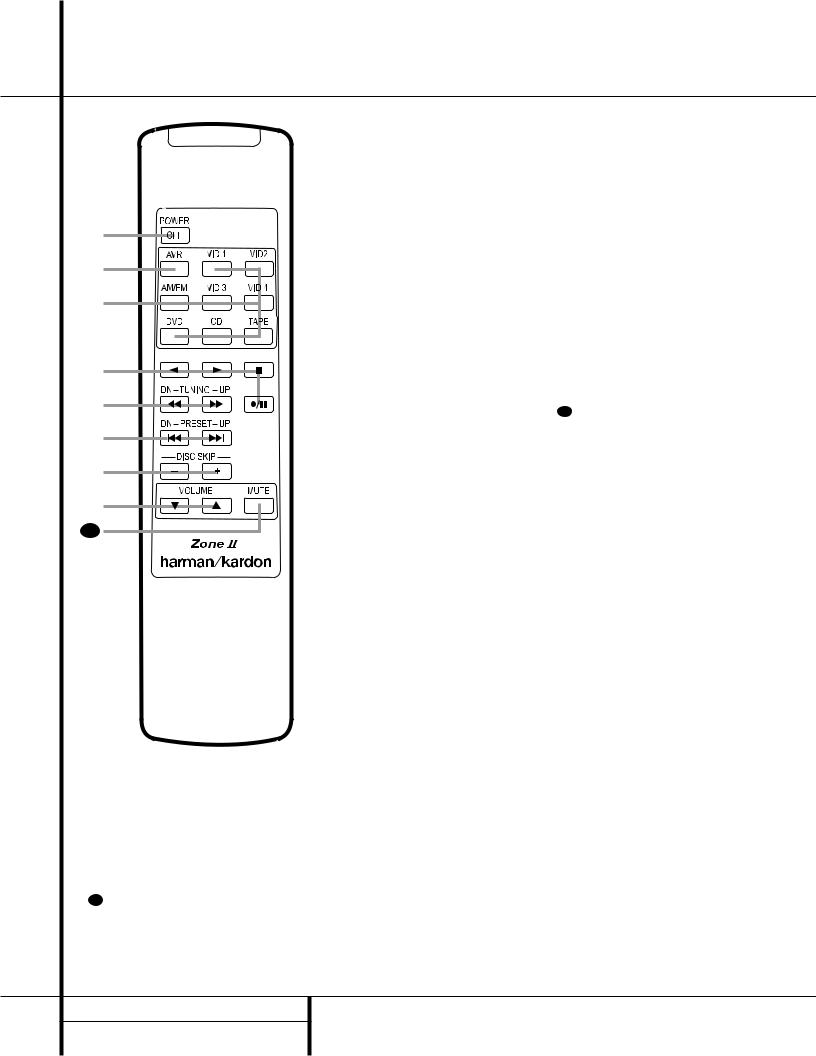
Zone II Remote Control Functions
å
|
ç |
ƒ
©
˙ |
I |
åPower Off: When used in the room where the AVR 7000 is located, press this button to place the unit in Standby. When it is used in a remote room with a sensor that is connected to the Multi IR jack b, this button turns the Multi-Room system on and off.
AVR Selector: Press this button to turn on the AVR. The input in use when the unit was last on will be selected.
çInput Selectors: When the AVR is off, press one of these buttons to select a specific input and turn the unit on. When the unit is already in use, pressing one of these buttons will change the input.
Transport Controls: These buttons control the Play, Pause and Stop functions of compatible Harman Kardon CD, DVD and cassette players.
Tuning Up/Down – Fast Play: When the AVR’s tuner is selected as the input source, these buttons will tune up or down through the frequencies of the chosen band. When a CD, DVD or cassette deck is selected, these buttons activate the Fast Play Forward or Fast Play Reverse functions.
ƒPreset Up/Down – Track Skip: When the AVR’s tuner is selected as the input source, these buttons will move up or down through the list of stations that have been stored in the preset memory. When a CD or DVD player is selected, these buttons activate the forward or reverse track or chapter skip functions.
©Disc Skip: When a compatible Harman Kardon CD or DVD changer has been selected, these buttons activate the Disc Skip function.
˙Volume Up/Down: When used in the room where the AVR 7000 is located, press this button to raise or lower the volume in that room. When it is used in a remote room with a sensor that is connected to the Multi IR Jack b, this button will raise or lower the volume in the remote room.
I Mute: When used in the room where the AVR 7000 is located, press this button to temporarily silence the unit. When it is used in a remote room with a sensor that is connected to the Multi IR Jack b, this button will temporarily silence the feed to the remote room only. Press the button again to return to the previous volume level.
å Power Off
AVR Selector ç Input Selectors
Transport Controls
Tuning Up/Down – Fast Play ƒ Preset Up/Down – Track Skip © Disk Skip
˙ Volume Up/Down I Mute
NOTE: The Zone II remote may be used in either the same room where the AVR 7000 is located, or it may be used in a separate room with an optional infrared sensor that is connected to the AVR 7000’s Multi IR input jack b. When it is used in the same room as the AVR, it will control the functions of the AVR or any compatible Harman Kardon products in that room. When it is used in a separate room
via a sensor connected to the Multi IR Jack b, the buttons for power, input source, volume, mute and the tuner will control the source and volume for the second zone, as connected to the Multi Out Jacks d. (See page 33 for complete information on using the Multi-Room system.)
14 ZONE II REMOTE CONTROL FUNCTIONS
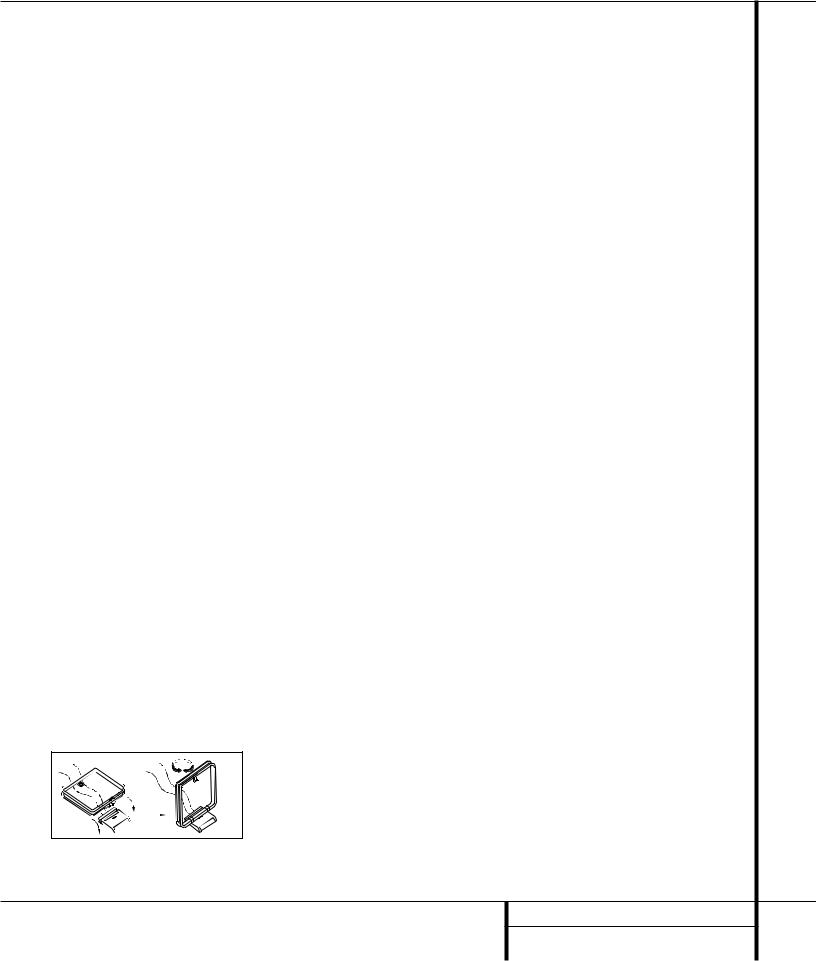
Installation and Connections
System Installation
After unpacking the unit, and placing it on a solid surface capable of supporting its weight, you will need to make the connections to your audio and video equipment.
Audio Equipment Connections
We recommend that you use high-quality interconnect cables when making connections to source equipment and recorders to preserve the integrity of the signals.
When making connections to audio source equipment or speakers it is always a good practice to unplug the unit from the AC wall outlet. This prevents any possibility of accidentally sending audio or transient signals to the speakers that may damage them.
1. Connect the analog output of a CD player to the CD inputs ¢.
NOTE: When the CD player has both fixed and variable audio outputs it is best to use the fixed output unless you find that the input to the receiver is so low that the sound is noisy, or so high that the signal is distorted.
2.Connect the analog Play/Out jacks of a cassette deck, MD, CD-R or other audio recorder to the Tape In jacks •. Connect the analog Record/In jacks on the recorder to the Tape Out jacks ‚ on the AVR 7000.
3.Connect the output of any digital sources to the appropriate input connections on the AVR 7000 rear panel. Note that the Optical and Coaxial digital inputs °· may be used with a Dolby Digital or DTS source or the output of a conventional CD or LD player’s PCM (S/P-DIF) output.
4.Connect the Coaxial or Optical Digital Outputs ‡ on the rear panel of the AVR to the matching digital input connections on a CD-R or MiniDisc recorder.
5.Assemble the AM Loop Antenna supplied with the unit as shown below. Connect it to the AM and GND screw terminals ¡.
6.Connect the supplied FM antenna to the FM (75 ohm) connection ™. The FM antenna may be an external roof antenna, an inside powered or wire lead antenna or a connection from a cable TV system. Note that if the antenna or connection uses 300-ohm twin-lead cable, you must use the 300-ohm-to-75-ohm adapter supplied with the unit to make the connection.
7.Connect the front, center and surround speaker outputs ª to the respective speakers.
To assure that all the audio signals are carried to your speakers without loss of clarity or resolution, we suggest that you use high-quality speaker cable. Many brands of cable are available and the choice of cable may be influenced by the distance between your speakers and the receiver, the type of speakers you use, personal preferences and other factors. Your dealer or installer is a valuable resource to consult in selecting the proper cable.
Regardless of the brand of cable selected, we recommend that you use a cable constructed of fine, multistrand copper with a gauge of 14 or smaller. Remember that in specifying cable, the lower the number, the thicker the cable.
Cable with a gauge of 16 may be used for short runs of less than ten feet. We do not recommend that you use cables with an AWG equivalent of 18 or higher due to the power loss and degradation in performance that will occur.
Cables that are run inside walls should have the appropriate markings to indicate listing with UL, CSA or other appropriate testing agency standards. Questions about running cables inside walls should be referred to your installer or a licensed electrical contractor who is familiar with the NEC and/or the applicable local building codes in your area.
When connecting wires to the speakers, be certain to observe proper polarity. Remember to connect the “negative” or “black” wire to the same terminal on both the receiver and the speaker. Similarly, the “positive” or “red” wire should be connected to like terminals on the AVR 7000 and speaker.
NOTE: While most speaker manufacturers adhere to an industry convention of using black terminals for negative and red ones for positive, some manufacturers may vary from this configuration. To assure proper phase and optimal
performance, consult the identification plate on your speaker or the speaker’s manual to verify polarity. If you do not know the polarity of your speaker, ask your dealer for advice before proceeding, or consult the speaker’s manufacturer.
We also recommend that the length of cable used to connect speaker pairs be identical. For example, use the same length piece of cable to connect the front-left and front-right or surround-left and surround-right speakers, even if the speakers are a different distance from the AVR 7000.
8. Connections to a subwoofer are normally made via a line level audio connection from the Subwoofer Output fi to the line-level input of a subwoofer with a built-in amplifier. When a passive subwoofer is used, the connection first goes to a power amplifier, which will be connected to one or more subwoofer speakers. If you are using a powered subwoofer that does not have line-level input connections, follow the instructions furnished with the speaker for connection information.
Video Equipment Connections
Video equipment is connected in the same manner as audio components. Again, the use of highquality interconnect cables is recommended to preserve signal quality.
1.Connect a VCR’s audio and video Play/Out jacks to the Video 1 In jacks ion the rear panel. The Audio and Video Record/In jacks on the VCR should be connected to the Video 1 Out jacks h on the AVR 7000.
2.Connect the analog audio and video outputs of a satellite receiver, cable TV converter or television set or any other video source to the
Video 2 g or Video 3 f jacks.
3.Connect the analog audio and video outputs of a DVD or laser disc player to the DVD jacks j.
4.Connect the digital audio outputs of a DVD player, satellite receiver, cable box or HDTV converter to the appropriate Optical or Coaxial Digital Inputs °·.
5.Connect the Video Monitor Out e jacks on the receiver to the composite or S-Video input of your television monitor or video projector.
15 INSTALLATION AND CONNECTIONS
